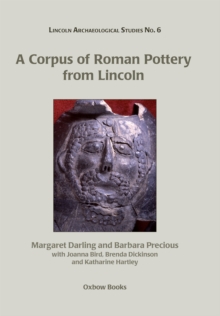
The Archaeology of the Lower City and Adjacent Suburbs Hardback
by Kate Steane, Margaret Darling, Michael J. Jones, Jenny Mann, Alan Vince, Jane Young
Part of the Lincoln Archaeology Studies series
Hardback
Description
This volume contains reports on excavations undertaken in the lower walled city at Lincoln, which lies on sloping ground on the northern scarp of the Witham gap, and its adjacent suburbs between 1972 and 1987, and forms a companion volume to LAS volumes 2 and 3 which cover other parts of the historic city.
The earliest features encountered were discovered both near to the line of Ermine Street and towards Broadgate.
Remains of timber storage buildings were found, probably associated with the Roman legionary occupation in the later 1st century AD.
The earliest occupation of the hillside after the foundation of the colonia towards the end of the century consisted mainly of commercial premises, modest residences, and storage buildings.
It seems likely that the boundary of the lower enclosure was designated before it was fortified in the later 2nd century with the street pattern belonging to the earlier part of the century.
Larger aristocratic residences came to dominate the hillside with public facilities fronting on to the line of the zig-zagging main route.
In the 4th century, the fortifications were enlarged and two new gates inserted.
Examples of so-called 'Dark Earth' deposits were here dated to the very latest phases of Roman occupation. Elements of some Roman structures survived to be reused in subsequent centuries.
There are hints of one focus in the Middle Saxon period, in the area of St Peter's church, but occupation of an urban nature did not recommence until the late 9th century with the first phases of Anglo-Scandinavian occupation recorded here.
Sequences of increasingly intensive occupation from the 10th century were identified, with plentiful evidence for industrial activity, including pottery, metalworking and other, crafts, as well as parish churches.
Markets were established in the 11th century and stone began to replace timber for residential structures from the mid-12th century with clear evidence of the quality of some of the houses.
With the decline in the city's fortunes from the late 13th century, the fringe sites became depopulated and there was much rebuilding elsewhere, including some fine new houses.
There was a further revival in the later post-medieval period, but much of the earlier fabric, and surviving stretches of Roman city wall, were swept away in the 19th century.
Information
-
Available to Order - This title is available to order, with delivery expected within 2 weeks
- Format:Hardback
- Pages:550 pages, b/w illustrations
- Publisher:Oxbow Books
- Publication Date:29/02/2016
- Category:
- ISBN:9781782978527
Information
-
Available to Order - This title is available to order, with delivery expected within 2 weeks
- Format:Hardback
- Pages:550 pages, b/w illustrations
- Publisher:Oxbow Books
- Publication Date:29/02/2016
- Category:
- ISBN:9781782978527










